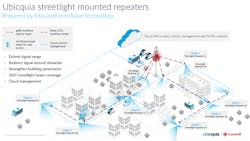The Overview
A strategic partnership between Ubicquia, a maker of intelligent infrastructure platforms, and Movandi, which manufactures 5G mmWave RF semiconductors, will result in mmWave smart repeaters that plug into a streetlight’s photocell socket in minutes.
Who Needs It & Why?
Though mmWave 5G provides up to 100X more capacity than 5G mid-band spectrum, propagation distance is typically <250 meters and mmWaves don't turn corners or get inside buildings very well. Network operators have already spent $4.5 billion to acquire mmWave spectrum. Now, in addition, if mmWave 5G is to deliver on its promise of pervasive gigabit-per-second throughputs in the face of booming demand, network operators must rapidly expand their infrastructure while keeping cost of ownership under control.
Such infrastructure expansion means that network operators need a readily available vehicle so that small cells can give their mmWave 5G networks enough sites to handle the capacity requirements. In urban settings as well as in less populated areas, existing streetlights could be the answer to the looming issue of deployment economics.
Under the Hood
Ubicquia's mmWave streetlight repeater uses existing streetlights and their persistent power, 50-meter spacing, and 8- to 10-meter heights to make millions of site-ready locations available at a fraction of the time and money spent building new poles for 5G radio base stations (gNBs) and pulling fiber to them (see figure).
The repeaters install in minutes, are barely visible at street level, and are configured and managed in the cloud to turn deployments into a single trip to the pole. They meet utility power, protection, metering, weight, and wind-loading requirements.
The repeaters ensure optimal outdoor coverage and user experiences by extending the range of 5G mmWave gNBs and redirecting its signals around obstacles. They lock onto host RAN (radio access network) signals automatically to ensure repeater-to-repeater connectivity without the need for fiber connectivity to the core network. On top of that, they integrate with all major RAN/Open RAN technologies, including Ericsson, Huawei, Nokia, and Samsung, and support all global mmWave spectrum bands.
Movandi comes into the picture with its mmWave 5G RF technology and reference design platforms. Its offerings range from RF semiconductors and custom phased-array antenna modules to algorithms and software including cloud APIs for management, control, and AI/ML data analytics.
On the fronts of speeding mmWave 5G deployment and lowering cost of ownership, Joe Madden, principal analyst at Mobile Experts, asserts that “streetlight-mounted repeaters present an incredible opportunity to dramatically speed up deployment schedules, streamline many regulatory and installation approval steps, and save money.”
He adds, “In our assessment of a small city requiring 950 new 5G mmWave radio base stations [gNBs] for full coverage, we found that using 100 streetlight-mounted gNBs and 850 repeaters reduces 10-year total cost of ownership by over $13 million or 35%, and by $89 million or 80% compared to a gNB-only utility-pole configuration. Our conclusion is that streetlight deployment is absolutely the way to go.”

